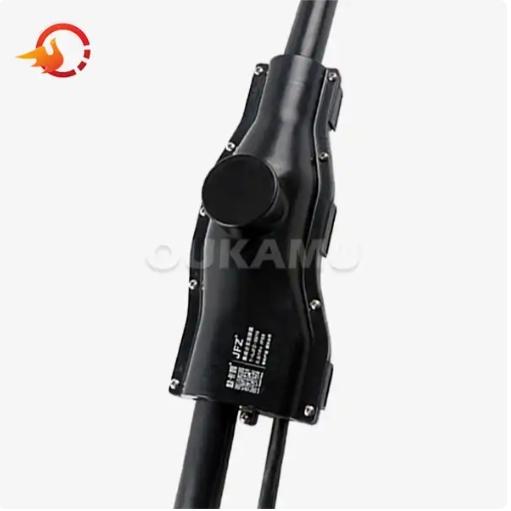Waterproof cable joint kits are essential in ensuring the reliability and longevity of electrical systems, especially in environments where moisture, water, and harsh conditions prevail. These kits provide vital protection to cable joints, preventing potential failures and hazards such as electrical shorts and corrosion. Understanding the science behind these kits can help industries like marine, offshore, and infrastructure ensure that their systems remain functional and safe. In this article, Oukamu will explore the principles behind waterproof cable joint kits, why they are critical for certain applications, and how they prevent damage in challenging environments.
1. What is a Waterproof Cable Joint Kit and How Does It Work?
A waterproof cable joint kit is an essential tool used to protect electrical connections from water, moisture, and environmental contaminants. These kits are designed to seal cable joints tightly, preventing water or any other harmful elements from coming into contact with the cables and causing damage. The primary function of these kits is to maintain the integrity of electrical connections, which, if exposed to water or moisture, could cause serious issues such as short circuits, corrosion, and electrical failures.
The science behind waterproof cable joint kits involves the use of a combination of materials that create a tight, durable seal. The key component in these kits is heat-shrink tubing. When the tubing is applied to the cable joint and exposed to heat, it contracts, tightly wrapping around the connection and creating a protective layer. This heat-shrinking process is the first line of defense against moisture ingress.
In addition to heat-shrink tubing, many waterproof kits incorporate sealing compounds such as resin or silicone gels. These compounds fill any small gaps between the cable and the joint, further preventing moisture from entering. The resin or gel also provides an additional layer of protection against other contaminants, such as dirt or chemicals, ensuring that the joint remains intact and operational over time.
2. Why Are Waterproof Cable Joint Kits Important for Marine and Offshore Environments?
Marine and offshore applications are particularly vulnerable to environmental challenges due to constant exposure to water, humidity, and saltwater. These conditions can accelerate the degradation of electrical cables and joints, causing them to corrode, short-circuit, or even fail entirely. Waterproof cable joint kits provide a vital solution by protecting electrical connections in such harsh environments.
In marine settings, cables and electrical systems are constantly exposed to seawater, which can cause corrosion and loss of conductivity. Saltwater is highly corrosive and can quickly degrade the metal parts of electrical connections, leading to failure. A waterproof cable joint kit ensures that moisture and saltwater do not come into direct contact with the cables, preserving their functionality and preventing corrosion.
Offshore platforms, where cables are subject to extreme conditions such as high winds, waves, and even submersion, benefit greatly from waterproof cable joint kits. These kits are designed to endure these challenging conditions, ensuring that electrical connections remain intact and operational even when submerged in water or exposed to high-pressure environments. In these critical industries, the failure of electrical systems could result in costly downtime or, in the worst case, safety hazards.
By using waterproof cable joint kits, businesses in marine and offshore industries can significantly reduce the risk of electrical failures, improve the reliability of their systems, and reduce maintenance costs.
3. How Do Waterproof Cable Joint Kits Prevent Corrosion and Short Circuits?
Corrosion and short circuits are two of the most significant threats to electrical systems, especially in environments where moisture and water are present. Corrosion can weaken electrical connections over time, causing them to degrade, while short circuits can result in system failures and pose serious safety risks. Waterproof cable joint kits are specifically designed to address these issues.
The primary function of these kits is to prevent moisture from coming into contact with the electrical conductors inside the cables. When water or moisture enters a cable joint, it can create a conductive path between the wires, resulting in a short circuit. This is particularly problematic in high-voltage systems, where a short circuit could lead to dangerous outcomes, such as electrical fires or equipment damage.
Waterproof cable joint kits use heat-shrink tubing to form a tight seal around the cable joint, preventing moisture from entering. The resin or gel compounds that are often used in these kits provide additional protection by filling in any gaps between the cable and the joint, ensuring that there are no entry points for water. This airtight and waterproof seal significantly reduces the risk of corrosion, as it prevents the cables from coming into direct contact with water or corrosive elements like salt.
Additionally, these kits offer resistance to chemicals and environmental contaminants, further ensuring that the electrical connections remain secure and free from corrosion. By keeping the joints dry and protected, waterproof cable joint kits help maintain the integrity of electrical systems, reducing the likelihood of short circuits and the need for frequent repairs.
4. What Are the Benefits of Using Waterproof Cable Joint Kits in Industrial Applications?
Waterproof cable joint kits offer numerous benefits in industrial applications, where cables are often exposed to harsh conditions such as dust, humidity, and temperature fluctuations. Whether in construction, manufacturing, or energy distribution, using waterproof cable joint kits helps ensure the longevity and reliability of electrical systems.
-
Reliability: Industrial environments often require robust and reliable electrical systems to ensure smooth operations. Waterproof cable joint kits provide this reliability by ensuring that electrical connections remain intact, even in the face of environmental challenges. By preventing water, dust, and other contaminants from entering the joints, these kits help keep electrical systems operational over time.
-
Cost Savings: Maintaining electrical systems can be expensive, especially if frequent repairs are needed due to moisture damage or corrosion. Waterproof cable joint kits significantly reduce maintenance costs by extending the life of electrical components and reducing the need for frequent repairs or replacements. This cost-saving aspect is crucial for businesses that want to minimize downtime and keep their operations running smoothly.
-
Safety: Electrical failures in industrial environments can result in significant safety risks, including electrical shocks, fires, and explosions. Waterproof cable joint kits help mitigate these risks by ensuring that electrical joints are sealed and protected, preventing the occurrence of short circuits and electrical malfunctions that could lead to safety hazards.
-
Versatility: Waterproof cable joint kits are highly versatile and can be used in various industrial applications, from power distribution systems to telecommunications and control systems. Their ability to protect electrical joints in different environments makes them an indispensable tool for modern industrial applications.
5. What Factors Should You Consider When Choosing a Waterproof Cable Joint Kit?
Selecting the right waterproof cable joint kit is critical to ensuring the long-term performance and reliability of your electrical system. Several factors should be considered when choosing a kit, including material quality, ease of installation, environmental resistance, and overall durability.
-
Material Quality: The materials used in the waterproof cable joint kit should be of high quality to ensure durability and effectiveness. Heat-shrink tubing should be made from materials that can withstand high temperatures without degrading, and sealing compounds should offer excellent waterproofing and corrosion resistance properties.
-
Ease of Installation: A good waterproof cable joint kit should be easy to install, with clear instructions and components that are user-friendly. Kits that require minimal tools and expertise to apply can help reduce installation time and costs.
-
Environmental Resistance: The kit should be able to withstand a variety of environmental conditions, including exposure to UV rays, extreme temperatures, and chemicals. Waterproofing isn’t the only consideration—protection against UV degradation and environmental wear is equally important.
-
Durability: Durability is a key factor when choosing a waterproof cable joint kit. The kit should be able to withstand harsh conditions for extended periods without losing its sealing properties. Look for kits with high ingress protection (IP) ratings to ensure that they provide long-lasting protection.
Conclusion
Waterproof cable joint kits are a vital component for ensuring the protection and longevity of electrical systems in challenging environments. By preventing moisture, corrosion, and short circuits, these kits help improve the reliability of electrical systems across industries such as marine, offshore, and industrial sectors. Understanding the science behind waterproof cable joint kits and the factors to consider when choosing them can help businesses make informed decisions that contribute to system efficiency, safety, and cost-effectiveness.
At OUKAMU, we’ve pioneered the world’s first Branch Cable technology, offering exclusive solutions for cable branch connections across multiple sectors, including infrastructure, residential, commercial, and industrial markets. Contact us at [email protected] for more information.
References:
- 3M, "Marine Cable Joint Kits." 3M.
- HellermannTyton, "Marine Electrical Solutions." HellermannTyton.
- Raychem, "Waterproofing for Marine Applications." Raychem.
- NEMA, "Guidelines for Waterproof Cable Seals in Marine Applications." NEMA.
- Offshore Technology, "Waterproof Cable Systems for Offshore Platforms." Offshore Technology.






